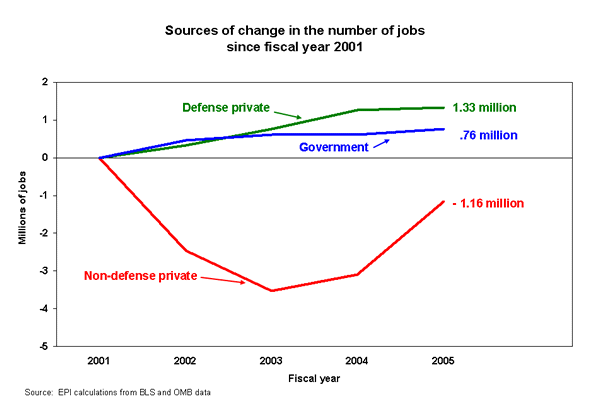See Snapshots Archive.
Snapshot for August 3, 2005.
Without defense-related spending, private sector would still be in a jobs hole
The private sector has 1.2 million fewer non-defense-related jobs today than it had four years ago. Only as a result of increases in government spending over the past four years, mostly on defense, does the private sector have more jobs now than it did before the recession.
Federal, state, and local government spending has created 2.1 million jobs in the last four years.1 According to the administration’s budget report, defense spending is generating 1.33 million more jobs in the private sector this fiscal year (for a total of 3.85 million jobs) than it did four years ago (2.52 million). At the same time, government jobs have increased by 760,000. In a fully employed economy, the additional 1.2 million jobs generated by government spending would have caused a reduction in jobs in other parts of the economy. But because the current labor market is so weak, the spending by people holding these 2.1 million new jobs has actually resulted in what is known as a “multiplier effect,” leading to the creation of even more jobs in the labor market.
Including defense-related jobs, by the end of the fiscal year the private sector is likely to have about 170,000 more jobs than four years ago.2 If private-sector jobs continue to grow at their recent pace through fiscal year 2005, the private sector will have 111.4 million jobs compared to 111.2 million in fiscal year 2001.

Defense spending gave its largest single-year boost to private-sector jobs in the fiscal year that ended in September 2004. In that year alone, defense spending directly generated almost half a million jobs (495,000). The multiplier effect from that spending no doubt contributed to the other 434,000 jobs added in the private sector that year. By contrast, in this fiscal year, additional defense spending is supporting only 70,000 more jobs, a small fraction of the 2 million private-sector jobs being added this year.
These numbers show both the profound weakness of private-sector job creation for most of the last four years and the capacity of government spending to offset some of that weakness. At the current pace of job creation, it will be another five or six months before non-defense-related jobs recover to the level of four years ago.
Notes
1. This estimate does not include private-sector jobs resulting from more spending for homeland security, health, education, and other purposes.
2. In the most recent month (June), private-sector jobs were only 103,000 higher than for December 2000, the peak month of fiscal year 2001.
This week’ Snapshot was written by EPI research director Lee Price with research assistance from David Ratner.
